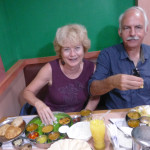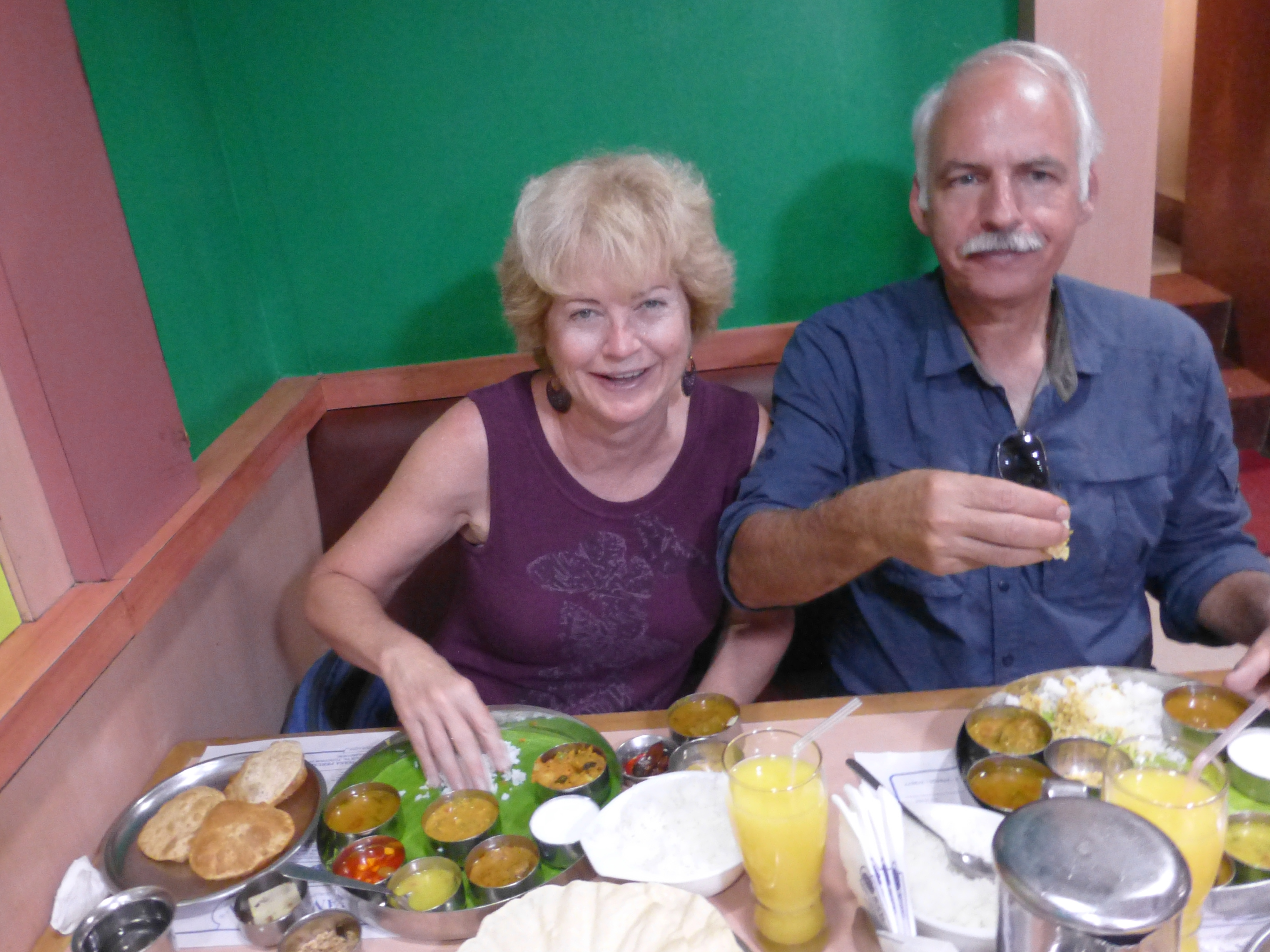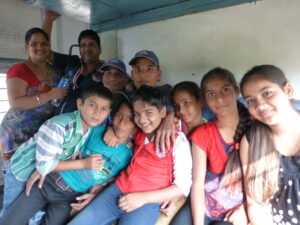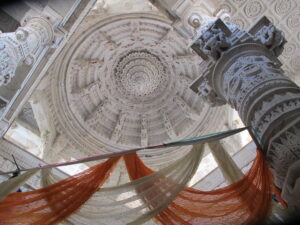
In India, it is customary to use different hands for different important functions. Think right hand pure; left hand, impure. You pass an object over to another with the right. You eat with the right hand, deftly breaking your pav bread or naan with the digits of one hand and dipping the bread into the sauce. Or you pour some marsala dish from your thali platter onto your rice, mix it up and scoop a chunk into your mouth, again with the right hand.
With the left hand, you – well – clean up what happens some hours later.
In just a few days in India, we have experienced so much righthandedness from people here, assistance when needed or a smiling interest in connecting with us. Yet, we’ve also seen a good deal of lefthandedness, efforts to gain money from us despite our interests, to overprice, to exploit in some way.
Both are endemic to the Indian culture – a sincere goodwill and friendliness on the one hand; and, on the other, a system of extracting baksheesh wherever one can.
The struggle for a foreigner here is to know the difference, when the left hand is extended or when it’s the right hand.
Even in a few days here, we have benefited from many right-hand kindnesses.
We arrived at the Delhi airport at 4am, and though surely looked foreign we somehow were missed by the driver who came to pick us up. We took a taxi instead and found ourselves negotiating narrow warrens of streets in the dark, futilely looking for a building with our number on it. The driver was both patient and persistent, however, bringing us as close as he could to a building at the end of two intersecting alleys. We truly appreciated the effort he gave, but this was not what we had expected, not at all.

Worse yet, no one was at the apartment house to let us in, and there were four unmarked apartments in the building. With a few stray dogs and a few stray people awake, we started to scrounge around for help. We found a couple just arriving in the street who were willing to call the phone numbers we had from our booking. Service switched off at that number, they reported. We banged on the lower apartment door, waking its resident, who directed us to the next floor apartment, but we had no way in. A woman purchasing some flour from a corner convenience stall offered us the wifi access at her 4th floor walkup, though we couldn’t get that to work.
A neighbor starting her day knew how to rouse a matronly resident on the floor above (ring the hidden bell). After much heated discussion in Hindi, the woman upstairs got her son out of bed to make a call to the landlord for us. And delivered a couple of bottles of water downstairs in case we needed them. The landlord apparently rang up the housekeeper who was dead asleep inside, and at last – with all that help – we were in.
Since then, we’ve had many more examples of gracious helping hands. The gregarious young woman with the American accent from northeast India who comped us some drinks at her restaurant because she liked our story. And all the shop owners, security guards and just passers-by we’ve asked for directions. An amiable middle aged Indian customer at the fruit and veg stand who pointed us to the yellow melons as particularly sweet. Or the phone shop operator who helped us through the lengthy application forms and the startup process on the SIM chips for our mobiles. We’ve started thinking we’re among Kiwis in disguise.
And that doesn’t even count the bevy of assistants whom storekeepers array in the aisles, as a service standard, to get you what you need. Or their willingness to open boxes or let you try things out before buying.

But then there’s the lefthandedness. There was the guard at the colorful, contemporary Hindu temple Laxmi Narayan. He’s the one that guides foreigners to a room where they can store their shoes and cameras instead of at the regular checkstand. After we toured the multi-level building, he made sure we got our stuff back from the small locker and then asked for a tip. We gave him a modest but noticeable 30 rupees (about 60 cents) and pleaded lack of funds when he looked underpaid. As we were leaving, though, we noticed a sign just above where he had stood and next to an image of Lakshmi, the goddess of wealth and fortune: “Tipping of workers is not allowed at this temple.”
The most left-handed of all are the touts who wander the streets solely to “help” you find a shop – best prices – a shop that is paying them to direct you there. Apparently, hiring a street wanderer for that purpose is so cheap to the store that snagging even a few unsuspecting people pays off.
Annoying in their own way, but at least potentially useful, are the very unofficial guides who prowl the entrances at monuments or heavily touristed areas like Old Delhi. They suddenly sidle up to you, matching your pace, and start their well-honed pitch of what they can do, how qualified and valuable they are, etc. They have learned to play on fears – how dangerous we would find the bazaar area (“many pickpockets”), how much we would miss at the monuments, or how hostile the sleek, clean Delhi metro system could be (“very crowded now”), or ironically even how we won’t be cheated (“no cost to you, unless you want”). Those who are successful understand how to make their play. Many, it seems, deliver a reasonable service despite their intrusiveness.
Polite foreigners are tempted to converse with the left-handers, explaining their disinterest; locals just ignore them, walking by without a word. Using the Hindi for no, nahi – or more politely ji nahi – has also proved a more powerful way to turn them aside. Otherwise, just saying “no” in English appears merely to be an opening for a longer pitch.
And we do recognize that they are just trying to keep themselves afloat in a poor country, but the left-handedness breeds distrust, cynicism and annoyance even in locals. Yet how to tell them apart?
One real life example on our first day in central Delhi…In search of the official city tourist office – the DTTDC – to do a city tour, we’re trying to get our bearings on the circular array of grand colonnaded facades at Connaught Place. The street signs are hard to detect, but we’re getting oriented because the sections radiating from the center circle are clearly labelled as Block A, B etc. – and we have Google maps.
We find the right street at last, one of the radial roads out of the central section. We wait to cross a busy street to get there. A driver of an auto-rickshaw, looking to take the seemingly lost tourists somewhere, asks where we’re headed. Trying to disinterest him in in a very short hop, we tell him where we’re going. He tells us the tourist office has recently moved to the busy street we’re on, just a block away. Appreciatively, we walk a bit further, passing another Indian man who asks us where we’re from and where we’re going. As objects of interest in many cities, we’ve become accustomed to questions like that on the street. So we respond pleasantly. He confirms that the tourist office is indeed just ahead, and on the front it’s indeed clearly marked DTTDC.
There a genial agent, one of about a half dozen staff with seemingly nothing to do, explained that the normal city bus tour was probably full, though he would check, and that the HopOn-HopOff bus was not running very often, as it is not tourist season. For nearly the same price, about $15 USD, he offered us a driver for the day, who would take us to all the monuments we were interested in.
While we waited for the driver, he took about a half hour to propose an itinerary across northern India. No hard sell, either. In fact, we found it quite useful to have a month-long itinerary so clearly defined…and with an offer to set us up completely for it at what seemed a very reasonable price. For the rest of the day, the driver was as good as promised, skillfully and patiently negotiating the crazy streets of Delhi, touring us to the places we wanted to see and then, in the end, bringing us back to our place down in South Delhi. He even took us to our kind of eating place, one where the locals ate. A good day.
But this was not the official tourist office at all, as we discovered a few days later, just one of the many operators who’ve set up in Connaught Place to snag tourists and sell them services. Those helpful people we passed? Touts paid off for each tourist they bring in to the office. Yes, we were scammed. But not cheated: we were pretty pleased with how they helped us. Reportedly it’s hard to get much service from the official tourist office anyway.
Left-handed or right-handed? And when are the left-handed still worth it? Hard to tell.
A friend offered a rule of thumb on the street at least: if someone stops you, it’s liable to be a left-handed outreach. If instead you ask someone on the street for help, you’ll likely get right-handedness. Not a bad rule of thumb, but sometimes you never quite know. Her other rule: when in trouble, seek out a Sikh – ever reliable in a pinch.
(Also, for more pictures from India, CLICK HERE to view the slideshow at the end of the India itinerary page.)







Wow, you two are brave! I’d be too scared to go there. I admit it. All those “left-handed” people would suck me in for sure. I’m way too trusting. At least there are two of you going about the streets. It is quite an experience you’re living right now. Reminds me of the movie “The Best Exotic Marigold Hotel”. Did you see that one, about a bunch of retirees moving to India? Great movie with Judi Dench, Bill Nighy, Tom Wilkinson and Maggie Smith. Looking forward to reading about more of your adventures in the days to come.
Did see the movie; lot of fun, but they didn’t seem to hardly be in India at times.
Great stories….seems about par for the course! That arrival seemed insane….
It did look desperate for a while, but we made it with a little help from strangers.
The right/left handed piece was fascinating. I would have problems, as I am a southpaw. I recall that the Ayatollah Khomeni had an obsessive phobia about lefties.